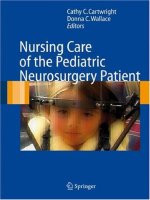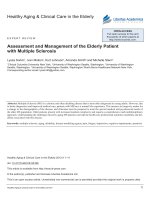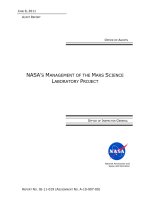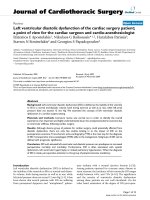Medical management of the hospitalized alcoholic patient
Bạn đang xem bản rút gọn của tài liệu. Xem và tải ngay bản đầy đủ của tài liệu tại đây (333.72 KB, 57 trang )
Medical Management of the
Hospitalized Alcoholic Patient:
Joseph S. Bertino Jr., Pharm.D.
CPRC
Goals and Objectives
Understand the pathophysiology of alcohol
withdrawal and treatment
Discuss how to use the Signs and
Symptoms Assessment (SSA) scoring
system to prevent and treat alcohol
withdrawal syndrome
CPRC
Classes of Drugs of Abuse
Anticholinergic drugs
Cannabinoids (marijuana)
Dissociative drugs (phencyclidine, ketamine)
Opiates (morphine, heroin)
Hallucinogens (LSD, mescaline)
Sedative-hypnotics (barbiturates,
benzodiazepines, alcohol)
Stimulants (amphetamine, cocaine)
Volatiles (glue, gasoline, paint remover)
CPRC
Drugs and Neurotransmitter
Actions that Cause Symptoms
GABA
5-HT
NE
AcCH
β
-endorphin Dopamine
Opiates
Dissociatives
Psychodelics
Stimulants
EtOH,
sedatives
GABA = γ-aminobutyric acid; 5-HT = 5-hydroyxtriptamine; AcCH = acetylcholine
CPRC
Why Are the Neurotransmitters
Important?
You cannot use the same strategies for
treatment or withdrawal from alcohol for
other drugs of abuse
The primary neurotransmitter affected by
chronic alcohol use is GABA
You must replace GABA to treat alcohol
withdrawal syndrome
CPRC
Etiology of Alcohol Withdrawal Syndrome
The brain adapts to chronic alcohol use
Alcohol potentiates the post-synaptic effect
of GABA (sedation)
Alcohol withdrawal causes a sudden
deficiency of GABA
Deficiency of GABA causes hyperactivity
in a patient…A large adrenergic
stimulation
CPRC
Etiology of Alcohol Withdrawal
Alcohol stimulates norepinephrine (NE)
synthesis and release
receptor sensitivity to NE is reduced
In acute alcohol withdrawal
NE synthesis continues
NE release decreases
NE receptors become are very sensitive
CPRC
Etiology of Alcohol Withdrawal
Dopamine receptor sensitivity increased by
alcohol
In acute alcohol withdrawal, dopamine receptors
become very sensitive
Kindling: repeated stimulation of brain causes
increased sensitivity of neurons
Repeated episodes of acute alcohol withdrawal
may stimulate kindling and seizures…each time a
patient has alcohol withdrawal syndrome the
symptoms are worse
CPRC
Alcohol Withdrawal Syndrome
(AWS)
AWS patients have a strong adrenergic
response
Due to sensitivity to norepinephrine and
dopamine
Due to lack of GABA receptor stimulation
CPRC
Stages of Alcohol Withdrawal
Syndrome
Stage 1: Autonomic hyperactivity (100%)
Occurs within hours of last use of alcohol and lasts
24-48 hours
Stage 2: Hallucinations (25%):
Occurs 8-48 hours after last use of alcohol
Stage 3: Brain stimulation and seizures (10%):
Occurs 6-48 hours after last use of alcohol
Stage 4: Delirium Tremens (DTs) (5%)
Occurs 2-5 days after last alcohol use, 15% die
CPRC
Alcohol Withdrawal Symptoms
Symptom
Onset after Usual duration
alcohol D/C
6-24 hr
48 hr
↑ Heart rate,
↑ BP
Hallucinations Variable
Variable
Seizures
6-48 hr
1-2 seizures
DTs
2-5 d
2-3 d
CPRC
Alcohol Withdrawal Symptoms
Symptom
Onset after
alcohol stops
Vivid dreams
Usual
duration
As EtOH Conc ↓ 48 hr
Insomnia
As EtOH conc↓
48 hr
Tremor
6-24 hr
48 hr
Nausea/vomiting 6-24 hr
48 hr
CPRC
Physical Signs of Acute
Alcohol Withdrawal (Stage 1)
Autonomic nervous system hyperactivity
restlessness
diaphoresis (sweating)
tachycardia
hypertension
tremors
nausea/vomiting
CPRC
Physical Signs of Acute Alcohol
Withdrawal (Stages 2 and 3)
Changes in perception, sensation, and
arousal may produce:
hallucinations
delirium
disturbed sleep
Brain Stimulation
may produce seizures
CPRC
Hallucinations (Stage 2)
Occur in 3-10 % of patients
Increased risk with use of larger amounts
of alcohol
Are not predictive of DTs (stage 4) and are
not necessarily related to DTs
May be auditory (hearing), tactile (feeling),
olfactory (smelling)
Patients are rarely disoriented (i.e. they
have ego-intact hallucinations)
CPRC
Hallucinations (Stage 2)
Hallucinations may be confused with
schizophrenia
Hallucinations may persist for weeks
Hallucinations may be permanent
CPRC
Seizures (Stage 3)
Usually 1-2 grand mal (tonic-clonic) seizures
Focal seizures are unusual
Second seizure usually occurs within 6 hours
after the first seizure
5-15% incidence
Occasionally, status epilepticus seen in < 3 % of
patients
CPRC
Seizures (Stage 3)
Seizure incidence increases with
increased or repeated alcohol abuse
(“kindling” phenomenon)
Predisposing factors for seizures:
Previous seizures for any reason
head trauma
previous alcohol withdrawal syndrome
seizures
CPRC
Delirium Tremens (Stage 4)
Most severe manifestation of alcohol
withdrawal
Affects < 5% of patients
Mortality 15%, due to:
myocardial infarction
respiratory arrest
sepsis
As age increases, risk of DTs increases
Rare in patients < 30 years of age
CPRC
Delirium Tremens (Stage 4)
Delirium tremens (DTs)
Large autonomic hyperactivity
gross tremor
delirium (hallucinations)
usually occurs after 3 days of untreated or
poorly treated AWS
may occur as late as 5-14 days after untreated
or poorly treated AWS
CPRC
Delirium Tremens (Stage 4)
Symptoms:
disorientation
confusion
visual hallucinations
Increased autonomic activity
Hyperpyrexia (increased temperature)
Treatment: Provide adequate sedation
(large, frequent doses of benzodiazepines)
cannot stop DTs once they have begun
CPRC
Medical Complications in
Patients with Alcoholism
Increased risk of all types of infections due
to:
decreased WBC function
decrease in other immunologic factors
Taking increased risks in lifestyle
Increased incidence of bacterial
pneumonia caused by pathogens rare in
the normal population
CPRC
Medical Complications in
Patients with Alcoholism
Increased risk of aspiration pneumonia
Increased risk of spontaneous bacterial
peritonitis (SBP)
Cardiomyopathy and arrhythmias
associated with alcoholism and withdrawal
Hypertension is common in alcoholics
CPRC
Assessment and Treatment of
Alcohol Withdrawal Syndrome
CPRC
The Problem
Patients may not tell physician about
alcohol use if they are not asked about it
Patients usually will state they use much
less alcohol than they really do use
Surgical patients may never be asked
about alcohol use
Homemade alcohol drinks may vary in
alcohol content
CPRC









